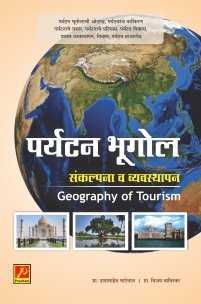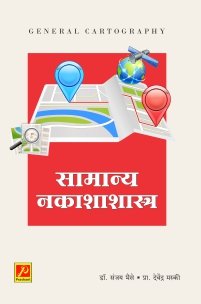GG-111 | Introduction to Physical Geography - I (Geomorphology)
F.Y.B.Sc. | Sem I | Geography
Authors:
ISBN:
₹175.00
- DESCRIPTION
- INDEX
F.Y.B.Sc. | Sem I | GG-111
GEOGRAPHY
Introduction to Physical Geography-I Geomorphology
The present textbook is written on the syllabus of F. Y. B. Sc Semester I – The Introduction to Physical Geography I – Geomorphology. It gives us a great pleasure to hand over the book to the students and teachers. We hope students and teachers will welcome this book by heart. The entire book is prepared on computer. All figures in the book are drawn on computer by Prof. Kiran Gavit under the guidance of Prin Dr. S. R. Chaudhari, therefore, the book has become more illustrative and informative. Most of all important points are explained by figures. This is the special feature of this book. There are in all more than 100 figures. As the figures are drawn by the authors themselves, the content displayed in the figures is more precise and accurate. The entire text is arranged in such way that the students can perceive the knowledge of Geomorphology very easily. Another special feature of this book is the exercise given at the end of every chapter. In this part we have tried to ask large number of objective and long answered questions. This will help to the students for preparing themselves for examinations at all levels.
1. Introduction to Geomorphology
a) Introduction to Physical Geography
Definitions of Physical Geograph,. Nature of Physical Geography, Development of Physical Geography, Scope of Physical Geography, Branches of Physical Geography
b) Geomorphology
Definition, Nature of Geomorphology, Scope of Geomorphology
c) Applied Geomorphology
2. The Earth System
a) Components of the Earth System
b) Geosphere
c) Atmosphere
d) Hydrosphere
e) Biosphere
3. Geological Time Scale
a) Geological Time Scale – Definitions
b) Superions
c) Eons
d) Eras
e) Periods
f) Epochs
4. Interior of the Earth
a) Interior of the Earth
b) Sources of information about the interior of the Earth
c) Behaviour of Seismic waves
d) Characteristic of Seismic waves
e) Composition and layers of interior of the Earth
5. Theory of Isostasy
a) Introduction
b) Characteristics of Isostasy
c) The concept of isostasy
d) Theories of Isostasy
e) Airy’s Theory of Isostasy
f) Pratt’s Theory of Isostasy
g) Comparison between theories of Airy and Pratt
h) Global Isostatic Adjustment
6. Wegener’s Continental Drift Theory
a) Wegener’s theory
b) Movement of landmasses
c) Wandering of continents from the Poles
d) Northward and Westward movements of the continents
e) Mountain building
f) Evidences in support of continental drift
g) Objections against the Continental drift theory
7. Crustal Movements
a) Endogenetic forcess
b) Diastrophic forcese
c) Horizontal movements
d) Landforms associated with horizontal movements
e) Fold
f) Types of folds
g) Faults
i) Types of faults
8. Theory of Plate Tectonics
a) Definition of the theory of Plate tectonicss
b) Important terms – Lithosphere, Asthenosphere
c) Lithospheric plates
d) Explaination of the Theory of Plate Tectonics
e) Plate margins or Plate boundaries
f) The power source for plate movements
g) Global system of lithospheric plates
h) Associated landforms
9. Earthquakes and Volcanoes
a) Earthquake
b) Types of earthquakes
c) Causes of earthquakesy
d) Effects of earthquakes
e) World distribution of earthquakes
f) Volcanoes
g) Types of volcanoes
h) Causes of volcanoes
i) Effects of volcanoes
j) Distribution of volcanoes
10. Rocks and Minerals
a) Definition of rocks and minerals
b) Types of Rocks
c) Ignious Rocks
d) Sedimentary Rock
e) Metamorphic Rocks
f) Economic importance of rocks
g) Economic importance of some rocks
11. Weathering
a) Definitions of denudation and weathering
b) Types of weathering
c) Physical or Mechanical weathering
d) Types of mechanical weathering
e) Chemical weathering
f) Types of Chemical weathering
g) Biological weathering
12. Mass movement
a) Meaning and Definition
b) Factors influencing Mass movement
c) Types of Mass movement
d) Slow flowage
e) Rapid flowage
f) Landslides
13. Fluvial Cycle of Erosion: Theory by W. M. Davis
a) The Theory of Divisian Cycle of erosion..
b) The Ideal Cycle of erosion Geomorphology – Definition, Nature and Scope.
c) The Theory of Cycle of erosion explained through various Stages of Cycle
d) Interruption of the Theory of Cycle of Erosion.
e) Evaluation of the Theory of Cycle of Erosion.
Related products
-
भू-माहितीशास्त्र
₹150.00 -
सामान्य नकाशाशास्त्र
₹135.00








